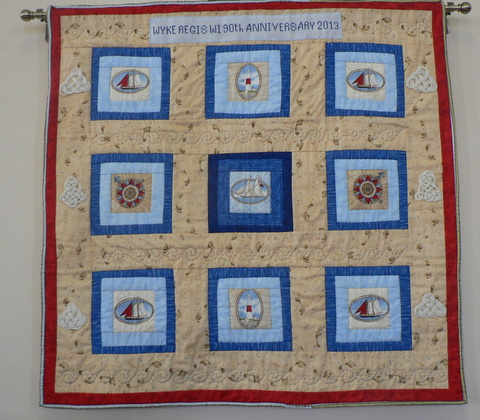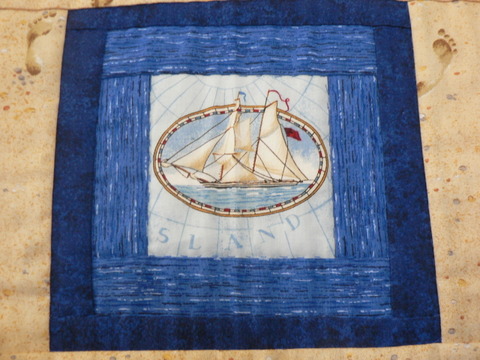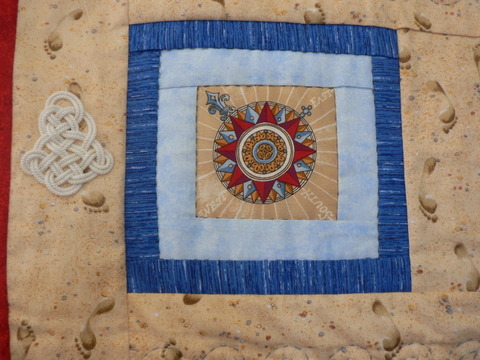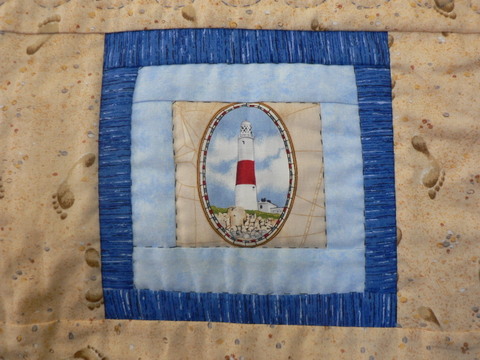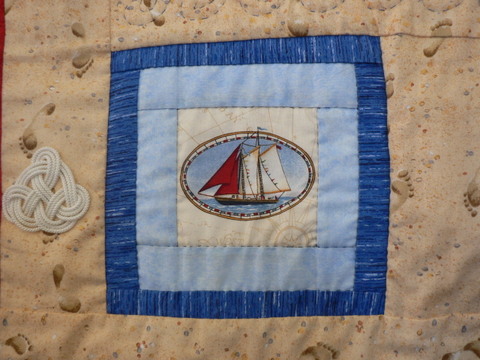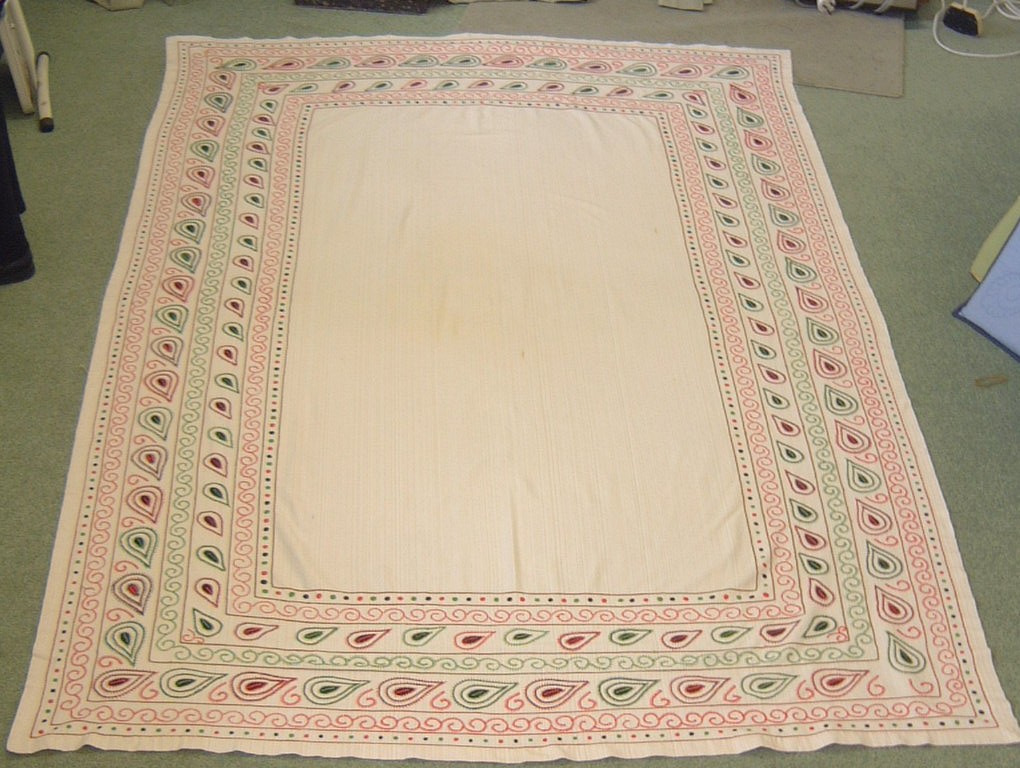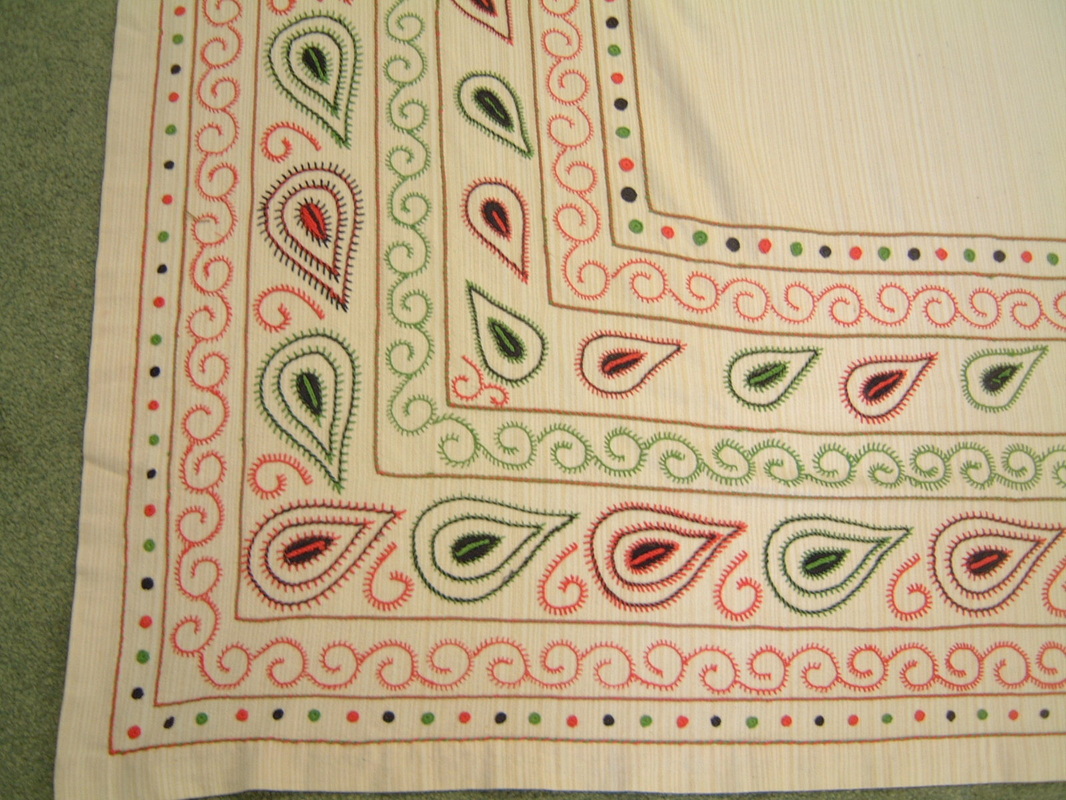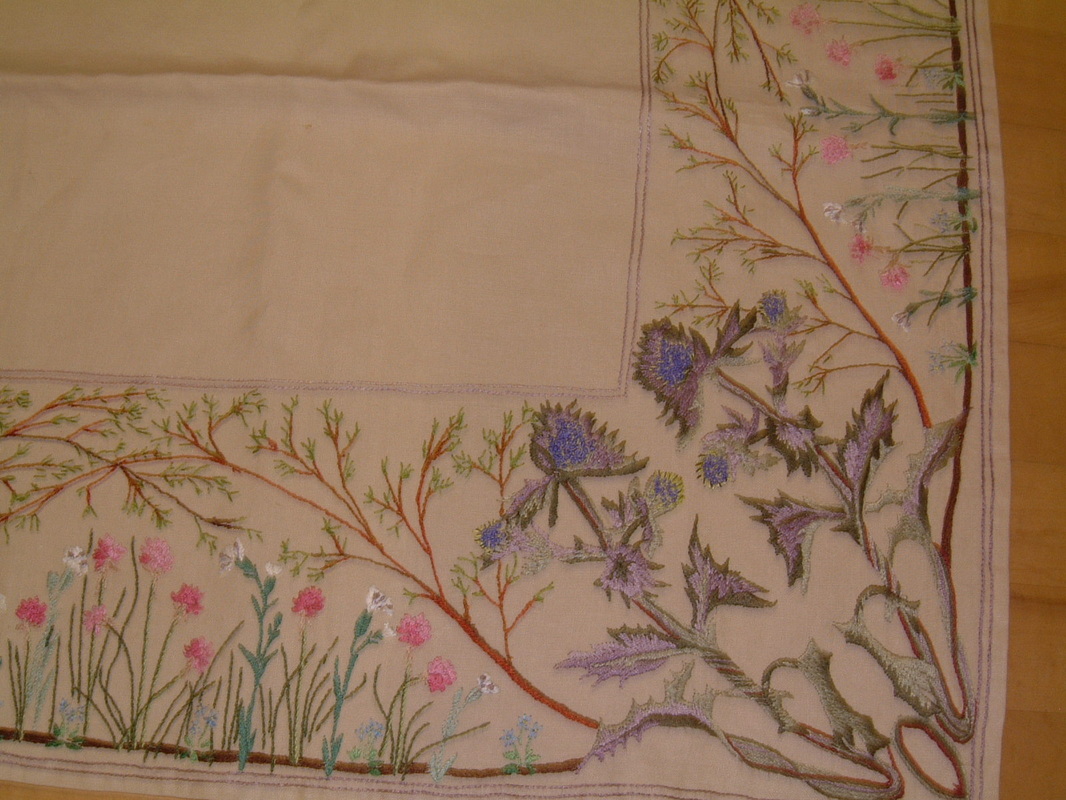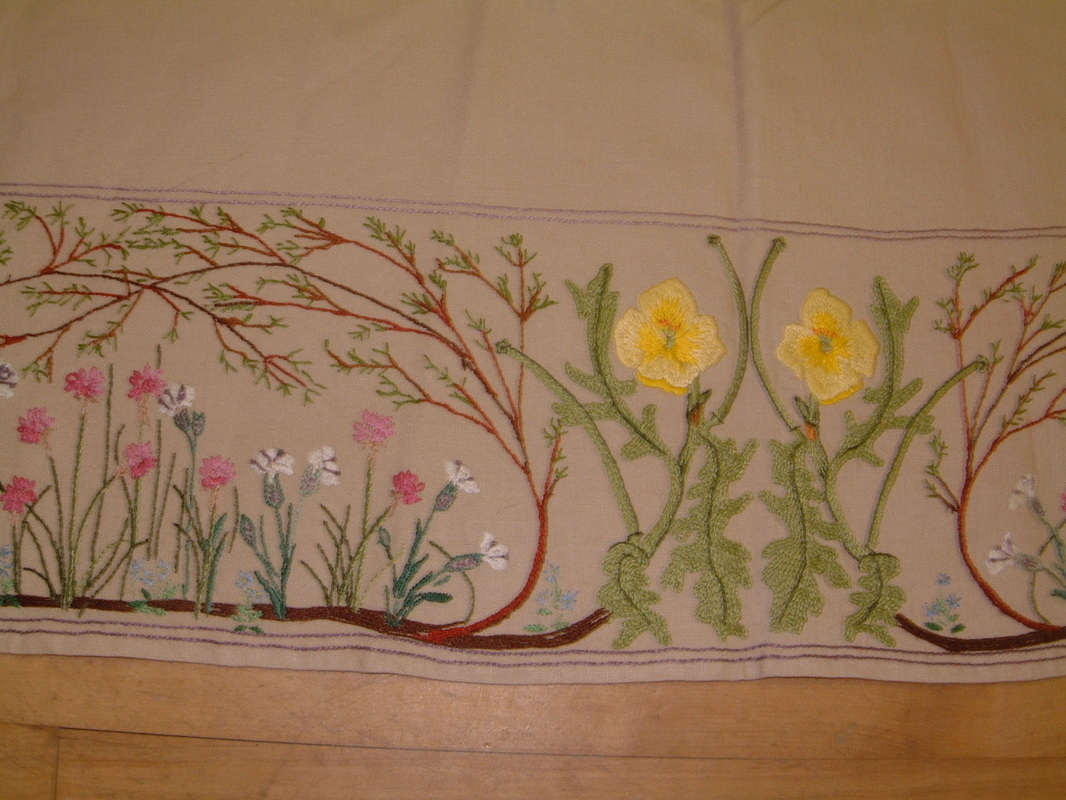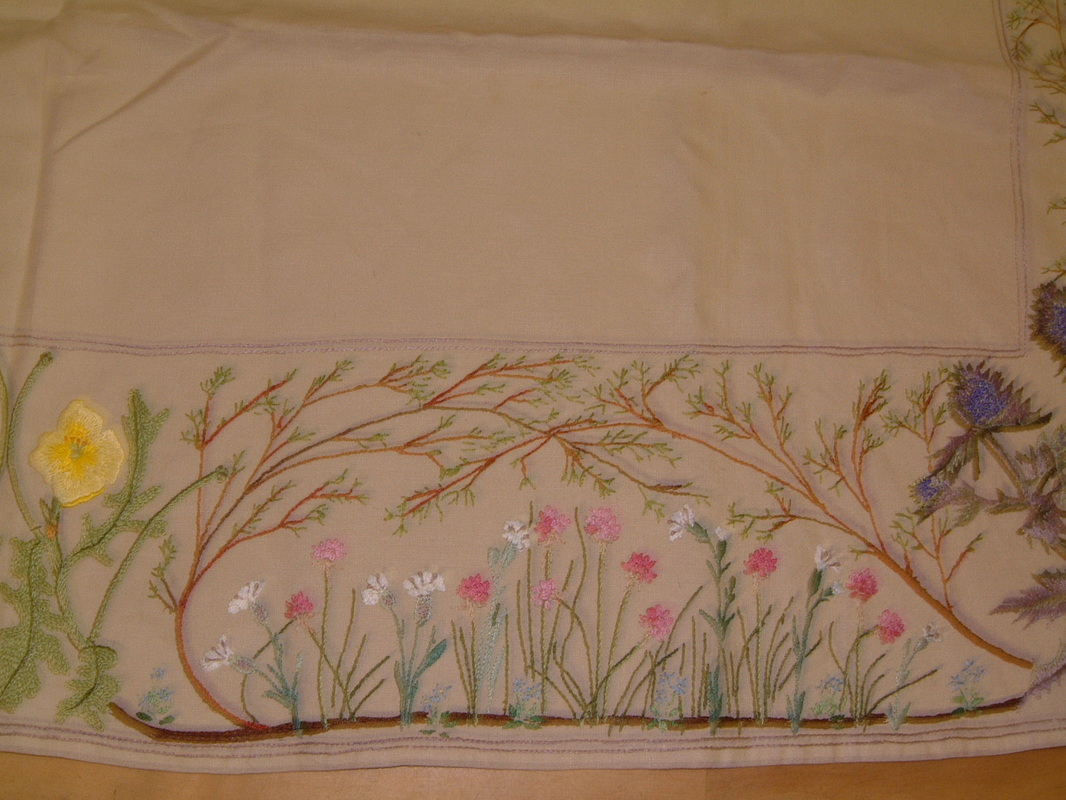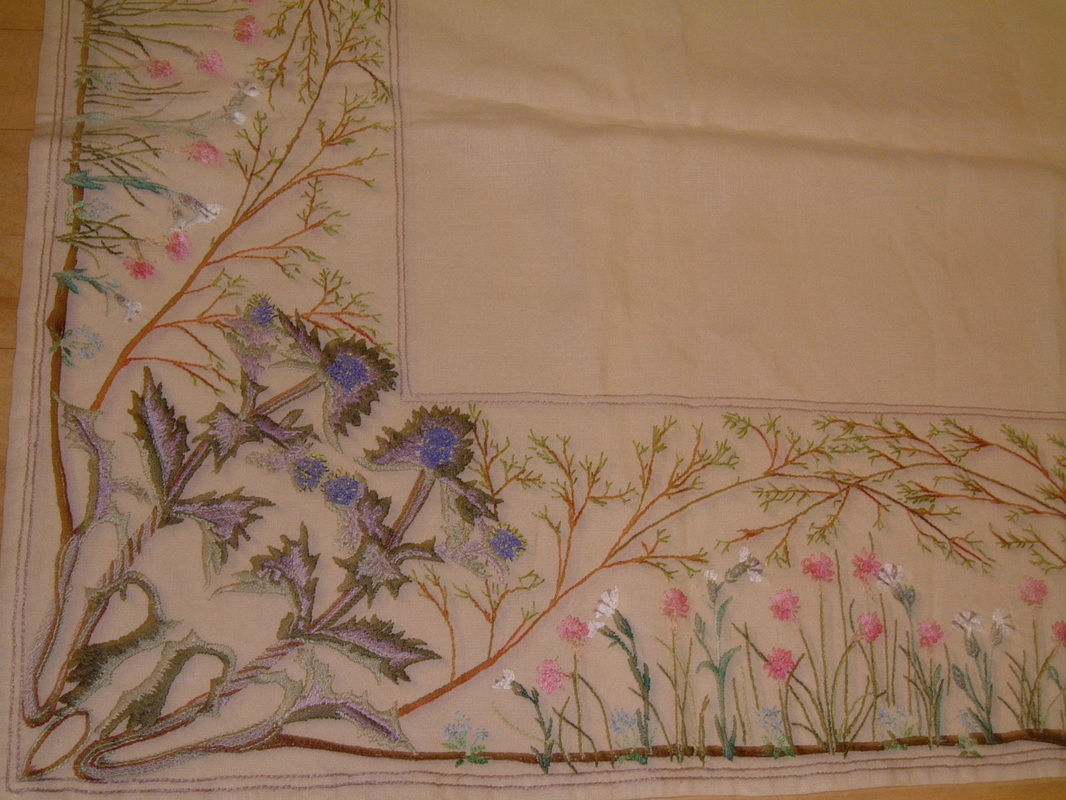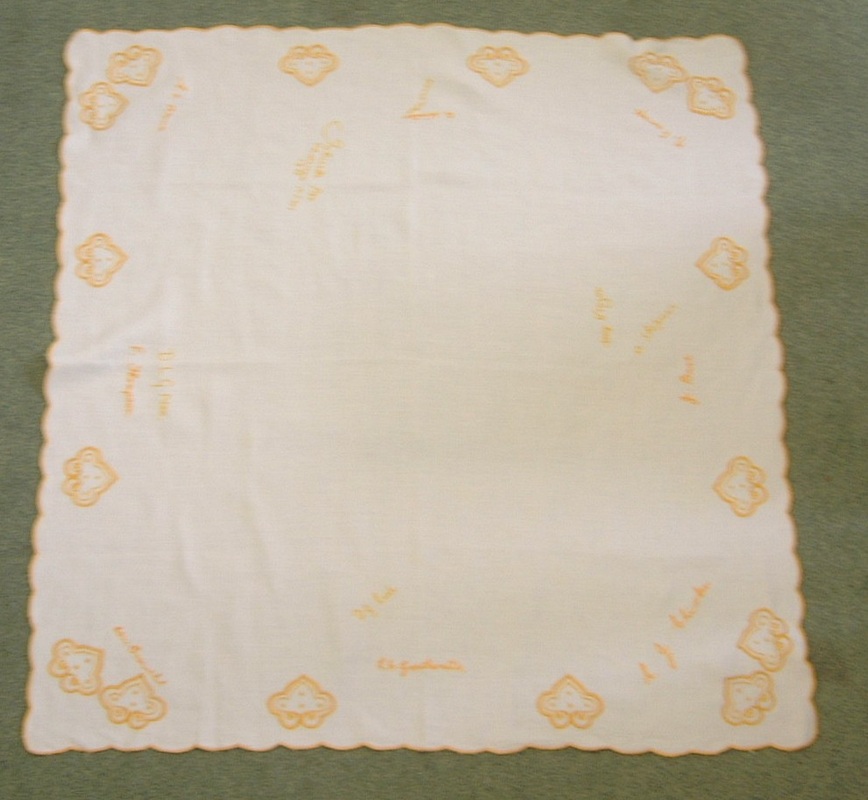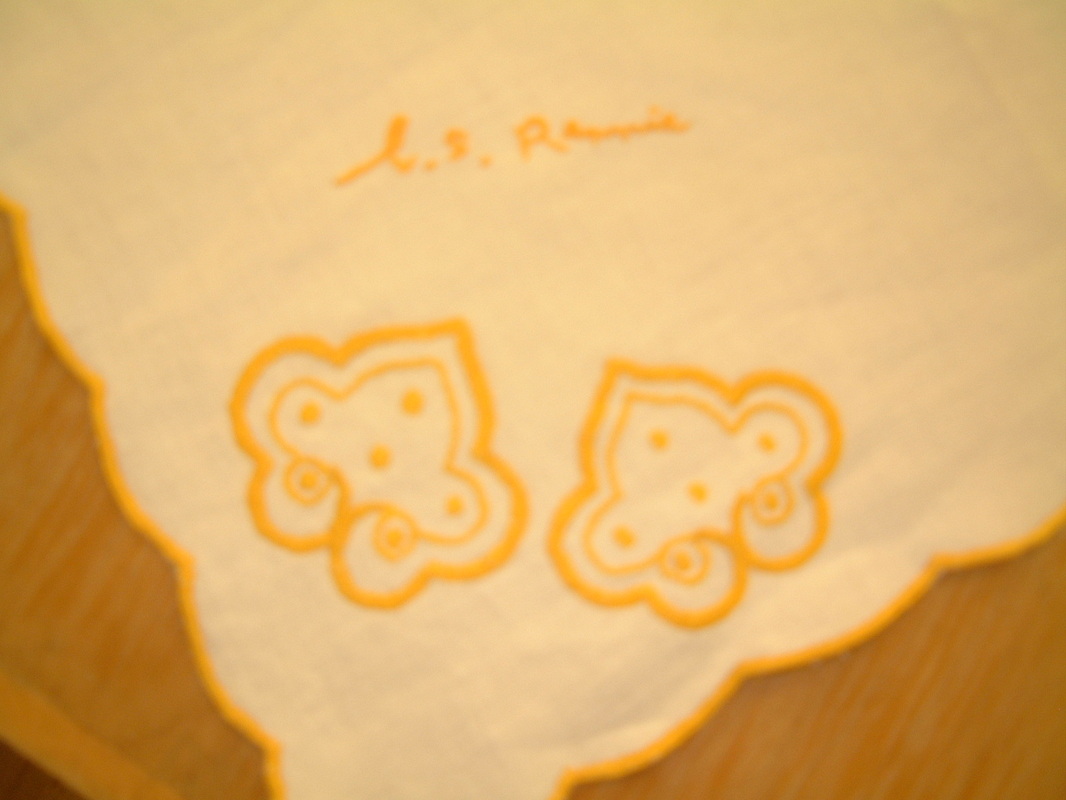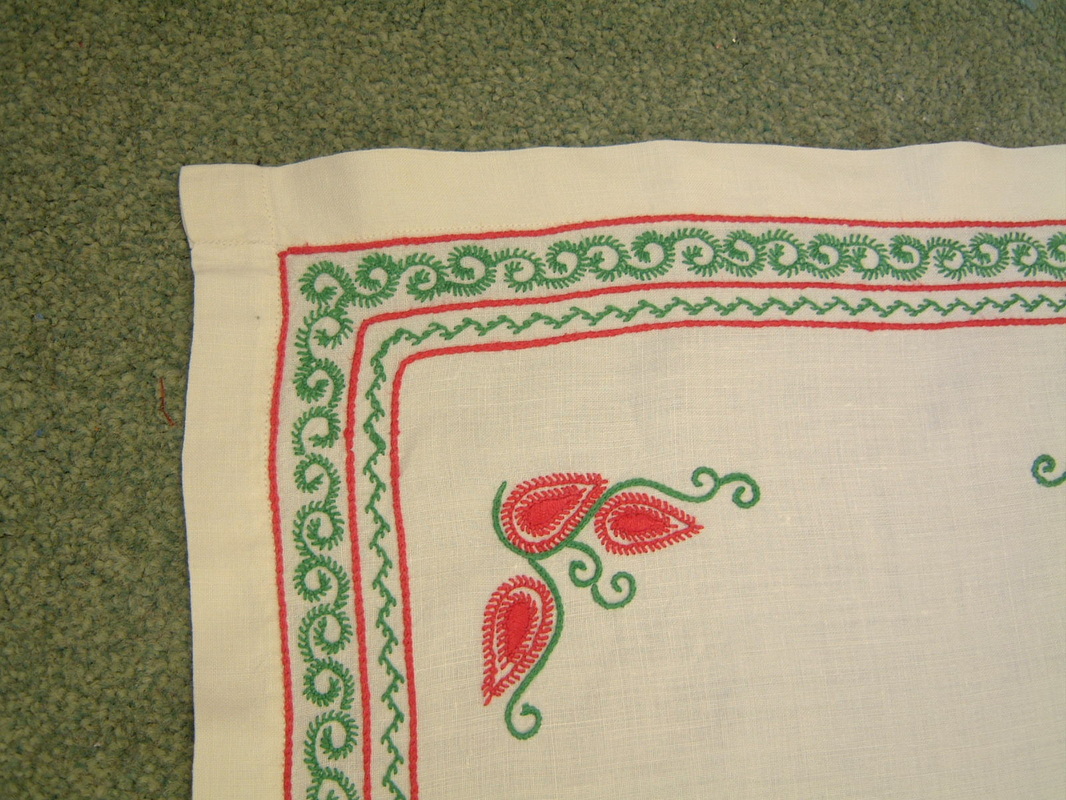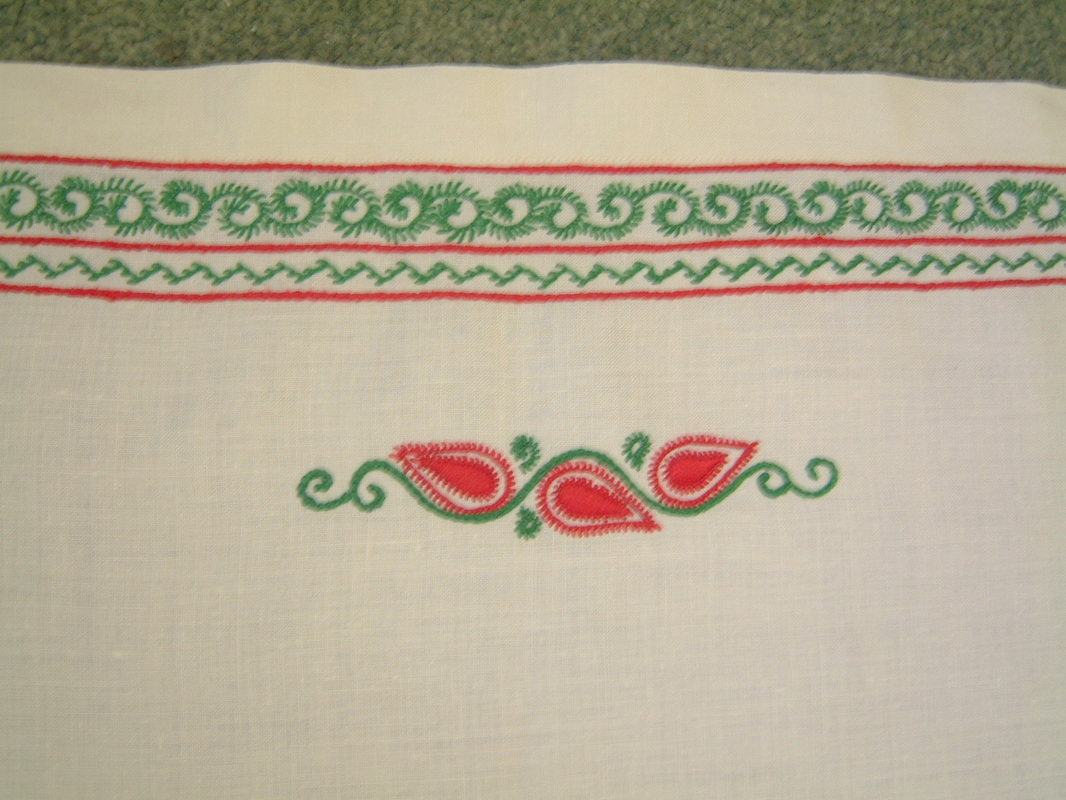CENTENARY ROSE
The rose which has been named to celebrate the centenary of the National Federation of Women's Institutes
in 2015 is thriving well in the Courtyard Garden.
in 2015 is thriving well in the Courtyard Garden.
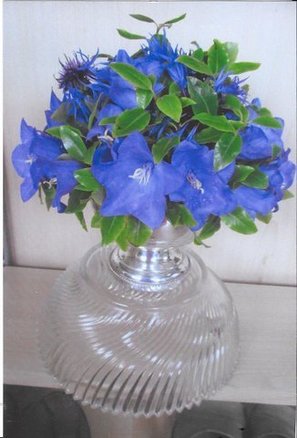
THE ROSE BOWL
The Rose Bowl was presented to the Institute by the Darby and Joan Club. Many years ago the club was given the use of the hall for their meetings. Frances Pick revived the use of the bowl this year with this lovely arrangement. It is hoped that the bowl will continue to be used at the monthly meetings for many years to come
THE ROSE BOWL
The Rose Bowl was presented to the Institute by the Darby and Joan Club. Many years ago the club was given the use of the hall for their meetings. Frances Pick revived the use of the bowl this year with this lovely arrangement. It is hoped that the bowl will continue to be used at the monthly meetings for many years to come
TEXTILES
The Institute is fortunate in owning a collection of textiles which have been accumulated over the years.
In 2004 these were catalogued and a CD and written record identifying the whole collection were sent to The National Needlework Archive at Boldre House, 5, Boldrewood Road, Southampton, SO16 7BW. Copies were made to keep in the Institute.
In 2004 these were catalogued and a CD and written record identifying the whole collection were sent to The National Needlework Archive at Boldre House, 5, Boldrewood Road, Southampton, SO16 7BW. Copies were made to keep in the Institute.
the 2013 banner
To celebrate the 90th Birthday of the Institute, the Craft Group have made a banner.
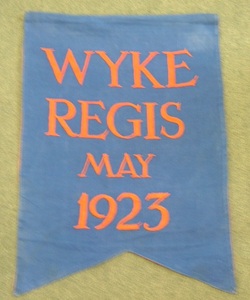
The designer and maker of this Blue Banner are unknown. It is possibly the first banner made and may have been for a County event..
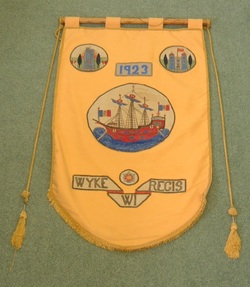
This Gold Banner is on display in the WI Hall and is thought to have been made in the 1930's. '1923' was stitched and attached by Kate Wyeth in the 1980's.
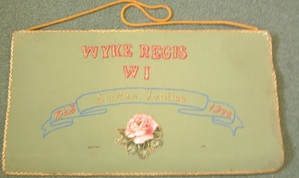
This banner was produced for the Golden Jubilee of the Institute in 1973
This tablecloth, worked in Dorset Feather Stitchery, was
made by the handicraft members between 1954 and 1955. They were led by Mrs.
Yolande who also designed the cloth. It is used at every meeting on the
President's table. It has recently been lovingly restored and laundered by Mrs. Penny Fielder.
made by the handicraft members between 1954 and 1955. They were led by Mrs.
Yolande who also designed the cloth. It is used at every meeting on the
President's table. It has recently been lovingly restored and laundered by Mrs. Penny Fielder.
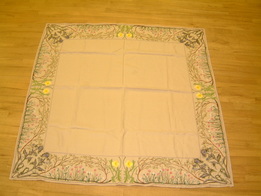
This is the Chesil Bank Group tablecloth.
It was made by Miss Symonds, the Head Teacher, and Miss Midgely, a teacher, both of Abbotsbury School.
The embroidery represents all the flowers from along the Chesil Beach.
|
This tablecloth bears several embriodered signatures including Mrs. Dorothy Lush, President of the Institute, and Mrs. Gabrielle Pike, National
Federation of Women's Institutes Chairman in 1965. Mrs. Pike came to open the 1965 Garden Party held in Portland House, Belle Vue Road, by kind permssion of the owner, Miss Bushby. |
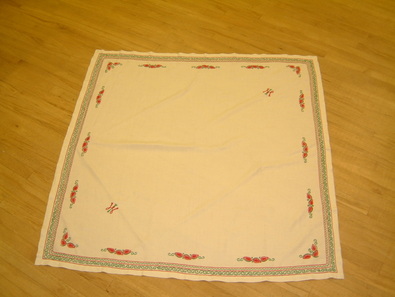
This tablecloth, worked in Dorset Feather Stitchery, belonged to Langton Herring WI. When this Institute closed the cloth was given to Mrs. Doreen Corbin whose mother was a Langton Herring President. Mrs. Corbin donated it to Wyke Regis WI.
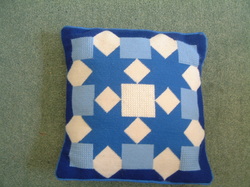
In 1996 Mrs. Avril Larsson designed and made three cushions for the chairs used at meetings by the President, Treasurer and Secretary.
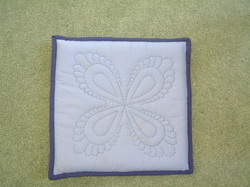
Since 2000 the Handicraft Group (now the Craft Group) have made comfortable cushions for those using the Hall. The designs vary and the covers are removable.
The Origins of Women's Institutes in England
1897 The WI founded in Canada.
The first Women's Institute was formed in Stoney Creek, Ontario, Canada as a branch of the Farmer's Institute. Inspired by a talk given by Adelaide Hoodless at a meeting of the Farmer's Institute. Local farmers Erland and Janet Lee were instrumental in setting up the new organisation. They were supported by Ontario government who appointed Laura Rose to be the first organiser in 1899. The movement brought women from isolated communities together and offered training in home economics, child care and those aspects of farming that were traditionally done by women, such as poultry keeping and small farm animal husbandry.
- See more at: http://www.thewi.org.uk/centenary/centenary-timeline#Origins
1915 The first WI in Britain
The Women's Institute movement in Britain started in 1915. Mrs. Alfred Watt came to England from Canada with the idea of starting Women's Institutes in England,s countryside for England's war-strained countrywomen.
During the First World War it was formed to encourage countrywomen to get involved in growing and preserving food to help to increase the supply of food to the war-torn nation. The first WI in Britain was formed under the auspices of the Agricultural Organisation Society (AOS). AOS Secretary, John Nugent Harris, appointed Canadian Madge Watt to set up WIs across the UK. The first one was at Llanfair PG, on Anglesey, North Wales on September 16th 1915, and the first WI in England was Singleton WI in Sussex.
- See more at: http://www.thewi.org.uk/centenary/centenary-timeline#Origins
1897 The WI founded in Canada.
The first Women's Institute was formed in Stoney Creek, Ontario, Canada as a branch of the Farmer's Institute. Inspired by a talk given by Adelaide Hoodless at a meeting of the Farmer's Institute. Local farmers Erland and Janet Lee were instrumental in setting up the new organisation. They were supported by Ontario government who appointed Laura Rose to be the first organiser in 1899. The movement brought women from isolated communities together and offered training in home economics, child care and those aspects of farming that were traditionally done by women, such as poultry keeping and small farm animal husbandry.
- See more at: http://www.thewi.org.uk/centenary/centenary-timeline#Origins
1915 The first WI in Britain
The Women's Institute movement in Britain started in 1915. Mrs. Alfred Watt came to England from Canada with the idea of starting Women's Institutes in England,s countryside for England's war-strained countrywomen.
During the First World War it was formed to encourage countrywomen to get involved in growing and preserving food to help to increase the supply of food to the war-torn nation. The first WI in Britain was formed under the auspices of the Agricultural Organisation Society (AOS). AOS Secretary, John Nugent Harris, appointed Canadian Madge Watt to set up WIs across the UK. The first one was at Llanfair PG, on Anglesey, North Wales on September 16th 1915, and the first WI in England was Singleton WI in Sussex.
- See more at: http://www.thewi.org.uk/centenary/centenary-timeline#Origins
A Century of campaigning
The WI has a long history of campaigning on a wide range of issues that matter to women and their communities. Over the past 100 years, WI members have campaigned to empower and support women within society, exerting their individual and collective influence; brought a series of controversial issues into the public domain; and brought about many changes in legislation and government policy.
In celebration of the WI Centenary we have put together a snapshot of campaign highlights, examining the WI's role promoting women's rights, fostering health awareness, encouraging sustainable development and building a fairer society.
- See more at: http://www.thewi.org.uk/campaigns/the-wi-history-of-campaigning#sthash.DjlkCTFb.dpuf
The SOS for Honey Bees campaign was launched after a resolution calling for increased funding for research into honey bee health was passed in 2009. Concerned that the outlook for bees remained bleak, despite funding for research and improved awareness of pollinator declines, the NFWI later joined with Friends of the Earth to campaign for more national leadership; the National Pollinator Strategy was launched in November 2014.
In the early 1990s the NFWI joined with CAFOD, Christian Aid, Oxfam, Traidcraft and the World Development Movement to become a founding member of the Fairtrade Foundation.
In 1986 the NFWI was one of the first organisations to talk about AIDS and used its unrivalled network of local organisations to educate the public and get people talking about the issue.
In 1975 the WI started informing members about the importance of breast examination and lobbying the government to set up screening clinics. A national screening programme was eventually introduced in 1988.
Members were among the first to debate the dangers of smoking when the WI passed a resolution to ban smoking in public places in 1964.
In 1954 a resolution to 'inaugurate a campaign to preserve the countryside against desecration by litter' led to the formation of the Keep Britain Tidy group and was influential in transforming litter policy following the introduction of the 1958 Litter Act.
The WI passed a resolution calling for 'equal pay for equal work' in 1943 and was represented for many years on the Equal Pay Campaign Committee.
Starting with a resolution in 1922, the WI campaigned throughout the 1930s and 1940s to increase the number of women police, lobbying the home office and winning the support of the Archbishop of Canterbury.
The WI first campaigned on jury service in 1921, urging women to 'accept their full responsibilities as citizens in whatever way they may be called upon to serve their country' and later urging the government to open up jury service to all.
- See more at: http://www.thewi.org.uk/campaigns/the-wi-history-of-campaigning#sthash.DjlkCTFb.dpuf
In celebration of the WI Centenary we have put together a snapshot of campaign highlights, examining the WI's role promoting women's rights, fostering health awareness, encouraging sustainable development and building a fairer society.
- See more at: http://www.thewi.org.uk/campaigns/the-wi-history-of-campaigning#sthash.DjlkCTFb.dpuf
The SOS for Honey Bees campaign was launched after a resolution calling for increased funding for research into honey bee health was passed in 2009. Concerned that the outlook for bees remained bleak, despite funding for research and improved awareness of pollinator declines, the NFWI later joined with Friends of the Earth to campaign for more national leadership; the National Pollinator Strategy was launched in November 2014.
In the early 1990s the NFWI joined with CAFOD, Christian Aid, Oxfam, Traidcraft and the World Development Movement to become a founding member of the Fairtrade Foundation.
In 1986 the NFWI was one of the first organisations to talk about AIDS and used its unrivalled network of local organisations to educate the public and get people talking about the issue.
In 1975 the WI started informing members about the importance of breast examination and lobbying the government to set up screening clinics. A national screening programme was eventually introduced in 1988.
Members were among the first to debate the dangers of smoking when the WI passed a resolution to ban smoking in public places in 1964.
In 1954 a resolution to 'inaugurate a campaign to preserve the countryside against desecration by litter' led to the formation of the Keep Britain Tidy group and was influential in transforming litter policy following the introduction of the 1958 Litter Act.
The WI passed a resolution calling for 'equal pay for equal work' in 1943 and was represented for many years on the Equal Pay Campaign Committee.
Starting with a resolution in 1922, the WI campaigned throughout the 1930s and 1940s to increase the number of women police, lobbying the home office and winning the support of the Archbishop of Canterbury.
The WI first campaigned on jury service in 1921, urging women to 'accept their full responsibilities as citizens in whatever way they may be called upon to serve their country' and later urging the government to open up jury service to all.
- See more at: http://www.thewi.org.uk/campaigns/the-wi-history-of-campaigning#sthash.DjlkCTFb.dpuf

